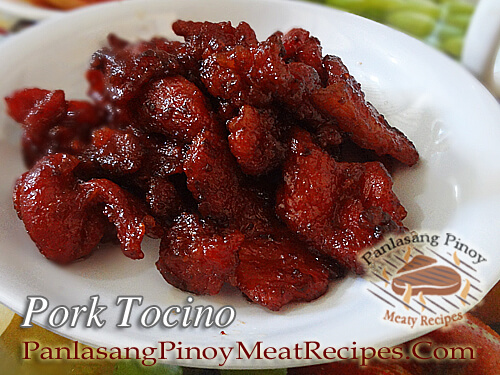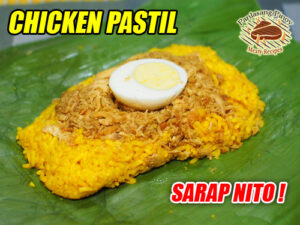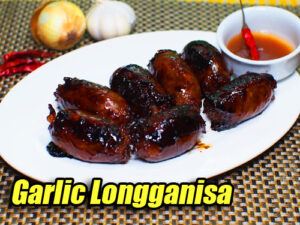Pork tocino is one of the popular pork dish for Pinoys but this dish, or maybe just the name was one of the Spanish influence that we inherited. Actually “tocino” is a Spanish word for “bacon” but when it comes to our cuisine, it is sweetened cured pork.
When it comes to Filipino cuisine, tocino is a classic dish that has been enjoyed by generations. This sweet cured pork is a popular breakfast food in the Philippines and can be served with rice, fried eggs, and tomato slices. While you can easily buy pre-packaged tocino in supermarkets, making it at home is not only healthier but also allows you to adjust the flavor to your liking.
Pork Tocino:A Filipino Breakfast Classic
When it comes to Filipino breakfasts, pork tocino is a dish that holds a special place in the hearts—and bellies—of many. Growing up, my mornings often began with the irresistible smell of tocino frying in the pan, a treat that seemed to promise a good day ahead. This sweet, cured pork dish, often paired with garlic rice and fried egg, has been a breakfast staple for generations of Filipinos. Although most people pick up ready-made tocino at the store, making it from scratch brings an extra level of satisfaction and a taste that’s unmistakably more vibrant and rich.
The Story Behind Filipino Pork Tocino
The name “tocino” actually has Spanish roots, where it traditionally refers to “bacon.” But as with many dishes in Filipino cuisine, we gave tocino our own twist, making it sweet rather than savory and smoky. My Lola Clara always reminded us that food is as much about memory as it is about flavor, and making tocino at home brings back memories of lively breakfasts at our family home in Pangasinan. According to my Uncle Tony, the sweetness in tocino became popular during the early Spanish colonial days, when sugarcane was widely cultivated and integrated into local dishes. While there’s no definite record on how tocino took on its sweet, unique Filipino twist, its flavors are deeply tied to our history and culture.
Why Make Pork Tocino from Scratch?
Sure, you can find pork tocino in just about any grocery store in the Philippines, but making it at home has its own rewards. Preparing homemade tocino lets you control the ingredients, skip preservatives, and adjust the sweetness or saltiness to suit your taste. My Ate Liza insists that store-bought versions can’t compare to homemade, especially when it comes to texture and flavor. Plus, if you’re looking for a healthier version, you can tweak the recipe to reduce sugar or use less oil when cooking.
Preparing the Ingredients for Sweet Cured Pork
To create the signature sweet taste of pork tocino, you’ll need a few key ingredients: brown sugar, garlic, soy sauce, pineapple juice, and a pinch of salt. Some folks like to add a bit of red food coloring to give the pork that rosy, vibrant color we often associate with tocino, but it’s totally optional if you’re aiming for a more natural look.
A tip from my Tita Marie is to use freshly pressed pineapple juice instead of the canned kind. She says the natural enzymes in fresh pineapple juice help tenderize the pork, giving it that melt-in-your-mouth quality. And she’s right—using fresh pineapple juice does make a difference, lending a slight tang that perfectly balances the sweetness. When it comes to choosing the pork itself, go for pork shoulder or pork belly, as these cuts have a good balance of meat and fat, ensuring each bite is juicy and flavorful.
Curing the Pork to Perfection
Curing is what gives tocino its unique flavor and texture. To start, combine all the ingredients—sugar, soy sauce, garlic, pineapple juice, a dash of salt, and food coloring, if using. Mix it until the sugar dissolves, and then add the pork slices, making sure to coat each piece thoroughly. My cousin Jaime taught me a trick he swears by: massage the mixture into the pork to make sure the flavors really penetrate the meat. You can let the pork marinate in a large ziplock bag or a sealed container to keep everything tidy and allow for even curing.
Once mixed, the pork needs to rest in the refrigerator for two to three days. This curing time is essential, allowing the meat to soak up the sweet and savory flavors completely. Remember not to rush this part—according to Jaime, patience is key to achieving that authentic, homemade tocino flavor we all crave.
Cooking Your Homemade Pork Tocino
When your tocino is done curing, it’s finally time to cook it up and enjoy! You can fry it or grill it, depending on your preference. For the classic pan-fried version, heat about four tablespoons of cooking oil in a skillet over medium-high heat. Carefully lay the pieces in, letting each side cook for about three minutes until browned but still juicy. Be mindful not to overcook the pork, as too much heat can make it dry and tough. The goal is a perfect caramelization on the outside with tender, juicy meat on the inside.
For those who prefer a smokier flavor, grilling is a fantastic option. Just make sure to cook it over medium heat, allowing the pork to cook through without charring too quickly. Whether you fry or grill, the result is a deliciously sticky, sweet, and savory tocino that’s bound to bring a little bit of morning magic to your plate.
A Hearty Breakfast, Filipino-Style
In our family, serving the tocino isn’t complete without a side of garlic fried rice and a fried egg, known as “tocilog.” There’s something nostalgic about this meal combination that transports you back to simpler days. Ate Liza often tops her tocilog with a few slices of fresh tomatoes and cucumbers to add a touch of freshness, and I’ve started to do the same—it’s a simple addition that complements the richness of the tocino.
So next time you’re in the mood for a traditional Filipino breakfast, why not try making tocino from scratch? Not only is it a satisfying way to spend time in the kitchen, but it’s also a delicious way to enjoy a piece of Filipino history with every bite. Whether you’re serving it for breakfast, lunch, or even dinner, homemade pork tocino is sure to become a beloved staple on your table, just as it has been for ours.
How To Make Pork Tocino (Sweet Cured Pork)
Ingredients
- 1/2 kilo pork shoulder or kasim slice into 1/4 inch thick
- 1/2 cup brown sugar
- 1/4 tsp red food coloring or annatto powder
- 2 Tbsp soy sauce
- 2 cloves garlic minced
- 1/8 cup pineapple juice optional
- 1/2 tsp. salt
Instructions
How To Make Pork Tocino (Sweet Cured Pork):
- Combine the ingredients: brown sugar, food coloring, soy sauce, garlic, pinepple juice and salt in a mixing bowl.
- Put the sliced pork in the bowl and rub the mixture liberally on all sides of the pork.
- You can either use a zip bag and put all the pork and mixture or in a tupperware container for curing the pork.
- Put inside a refrigerator and cure for 2 to 3 days.
- After curing the pork, you can either fry or grill it. Heat at least 4 tablespoons of cooking oil.
- Fry the tocino at least 3 minutes on each sides until browned on medium to high heat or until cooked.
- Don't overcook because it will become too dry and tough.
- Serve with fried egg and fried rice or java rice
Video
Watch the Video on How to Make Pork Tocino:
Notes
Cooking Tips:
Balance the Sweetness
When making tocino at home, it's important to balance the sweetness to avoid overpowering the natural flavor of the pork. Adjust the amount of sugar in the marinade based on your taste preference, and consider using natural sweeteners like honey or coconut sugar for a healthier twist. Taste the marinade before adding the meat to ensure it has the right balance of sweet and savory.Don’t Rush the Curing Process
Patience is key when curing the meat, as this step allows the flavors to fully develop and penetrate the pork. Let the pork cure in the refrigerator for at least two to three days to achieve the best results. Skipping this step or shortening the curing time can lead to a less flavorful and less tender tocino.Cook Over Medium Heat for Tender Meat
To prevent the tocino from becoming dry and tough, cook it over medium heat rather than high heat. This allows the pork to cook through evenly while the sugars in the marinade caramelize perfectly, creating a delicious crust without burning. If the heat is too high, the outside may burn before the inside is fully cooked, leading to a less desirable texture.






Hello! I tried doing tocino. But the meat is so tough. How come other tocino’s are so tender?
I think it depends on the kind of pork or what part of the pork you are using. Usually pork shoulder or pork butt is used. Also, the commercial tocino are using tenderizers to make it tender.
Hi Yvonne, some boil it in water first until tender then fry it in oil after.
Hi Pixie, thanks for the cooking tip!
Hi there! Is garlic necessary for this recipe?
Hi Sahlee, yes it is necessary.
So I have 2 pounds of meat do I just double the recipe then?
Yes you have to double ingredients in the recipe.
Hi Sarah, you can use rock salt or kosher salt.
Is the measurement of salt for Kosher salt or ordinary table salt? Thanks!
How long can i keep and freeze it? Can I keep it in the freezer for 1 month?
Hi Loise, Yes you can store it in a freezer for a month.
Hi! Can I use this tocino recipe for my food business? Thanks!
Hi Joys, what kind of food business? are going to sell the tocino uncooked and frozen or in a restaurant or canteen? Since this tocino does not have preservatives or other stuffs for curing the meat, I’m not sure about the shelf life.
Hi i tried to sell homemade tocino and i got their feedback so bad result 🙁 . Can u assure to me that this recipe is delicious? Is it tender even w/out sprite and vinegar?
Hi May, I can’t assure you if it will suit your taste. You can try a small quantity first, let say 1/4 kilo then cook and taste it.
I didnt use red colouring and cooked on electric grill, but was amazing!! Served with spicy rice, the sweet with spicy done it for me! Thanks for the recipe.
Hi Haley, My pleasure! thanks for visiting and sharing your comment!
Been using recipe for about 6 months. My filipina and I love it.
Hi Bert, I’m happy that this recipe blog helped you in your cooking tocino.
Hi Kris, you only need to add chili or what ever spices to make it spicy and no need to reduce the sugar. But you can reduce the sugar if you think the amount is too sweet. It will not affect the curing process.
Hi! I’ve never made or had tocino before. But I plan to make it for someone who had it in Korea. He said one place in particular served it spicy. So would I reduce the sugar or is the current amount necessary for the curing process?
i like to make it…. I love food
Hi thanks for sharing this tocino recipe. I was looking for a tocino recipe without preservative (salitre) like this one.
Do i need to put it in freezer? Tnx
Hi Anar,
If you will store it for a longtime, you need to put it in the freezer.